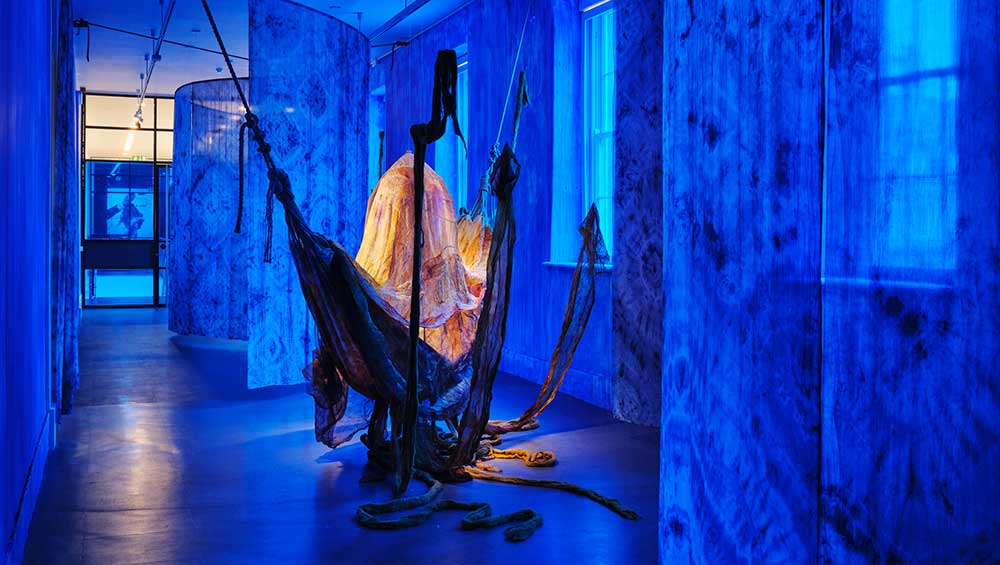
Alex Cecchetti, The Journey of One Breath, 2024. Installation view, Take a Breath, IMMA – Irish Museum of Modern Art, Dublin, 14 June 2024 - 17 March 2025. Photo: Ros Kavanagh.
Irish Museum of Modern Art, Dublin
14 June 2024 – 17 March 2025
by VERONICA SIMPSON
It starts with a deep breath, taken and then held: at the entrance to the main galleries of the Irish Museum of Modern Art (IMMA) we are plunged into an immersive installation by Alex Cecchetti, evoking the deep, underwater environments he experiences when he goes free diving (deep underwater diving without the use of breathing equipment). Dark blue, ink-stained walls frame indigo silk curtains, hand-dyed to replicate starbursts of sunlight as they would appear to a diver when underwater; the curtains themselves waft gently, powered by invisible fans. Two hammocks are hung along this blue corridor, offering us a moment to rest and enjoy projected footage of turtles, fish and other creatures that Cecchetti has filmed on his dives. There is also a hypnotic soundscape comprising fragments of ancient songs sung by Indigenous female divers from the Philippines; songs that have been passed down between generations for thousands of years. They remain earworms in my brain long after I have left.
Take a Breath, IMMA’s latest show, is an immersive artistic exploration of oxygen and its geological, cultural and political significance, wandering far and wide between eras (from 2.4bn years ago to the present), disciplines, regions and implications. Through the selection and choreography of works, it also plays with our own sense of time. There is an impression of shifting between zones, historically, politically and geographically, as we move through the enfilade of rooms; a feeling of time expanding and contracting around us. Cecchetti’s installation, commissioned for this show, creates an environment that is timeless and eternal, as does the adjacent room, which features a work from 1974 by Ana Mendieta, Burial Pyramid. She lies in a crevasse in the landscape, with rocks piled on top of her naked body; we see these rocks shifting around her torso as her lungs inflate and deflate. Either side of the screen is a selection of photos of the original performance.
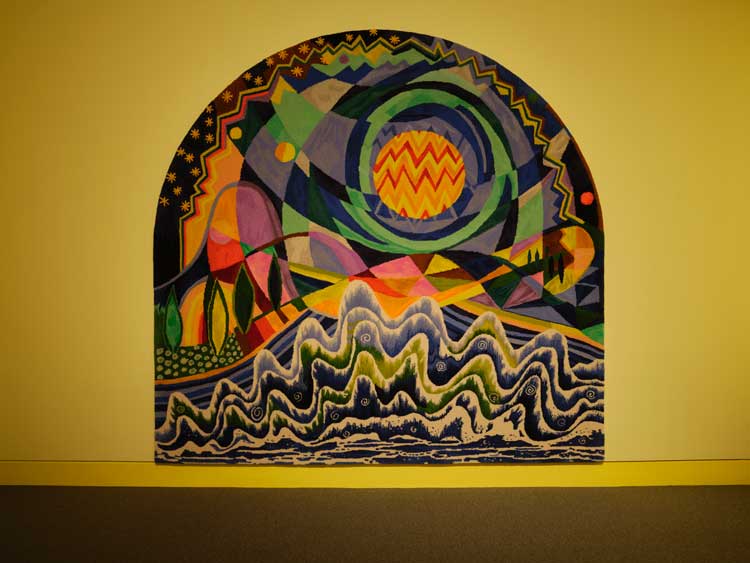
Isabel Nolan, Deep Time Day tapestry, 2024. Installation view, Take a Breath, IMMA – Irish Museum of Modern Art, Dublin, 14 June 2024 - 17 March 2025. Photo: Ros Kavanagh.
One of the newest works – Deep Time, a tapestry by Isabel Nolan, also commissioned for the show – takes us back a couple of billion years. Speaking at an event in the gallery in July, Nolan says: “I’m very interested in the time before oxygen, and all the species that died when oxygen became dominant. I am looking at that as an extinction event. Around 2.4 to 2.1bn years ago, the Earth was certainly toxic to the life forms that thrive on it now, humans included. Suddenly, oxygen became the dominant gas in the air.”
Such is the skill of IMMA’s head of programming, Mary Cremin, who curated this show, that she has woven a topic as multifaceted and intangible as oyxgen into the most compelling of curatorial experiences. During a tour of the show, she says the idea emerged during the global pandemic when it was realised that all oxygen is not equal – that access to good-quality air (from the air outdoors to the air available in hospital respirators) is rare as well as unevenly and unfairly distributed. She refers to the historian Achille Mbembe’s post-Covid essay The Universal Right to Breathe, in particular the following: “From a universal perspective, not only is it the right of every member of humankind, but all of life. It must therefore be understood as a fundamental right to existence.”
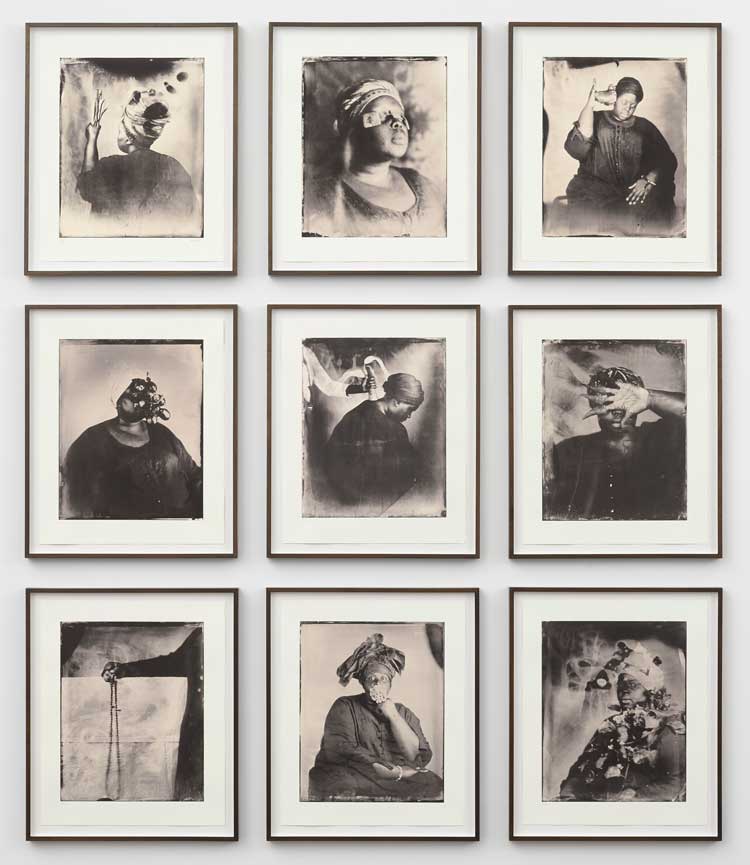
Khadija Saye. In this space we breathe series, 2017-18. Silkscreen print on Somerset Satin White 300gsm paper, 61.3 x 50.2 cm (24 1/8 x 19 3/4 in). © The Estate of Khadija Saye. Courtesy the Estate of Khadija Saye and Nicola Green.
The exhibition leaflet also throws in some alarming figures from the World Health Organization, which says pollution is “the single biggest environmental threat” to our species with “99% of the world’s population [living] in locations that are above WHO thresholds designed to protect human health”. In exploring this topic, Cremin includes work about pollution, from forest fires and volcanoes to incursions by illegal surveillance aircraft, as well as fires caused by criminal negligence; one of the most moving rooms is filled with photographs taken by Khadija Saye, who died in the Grenfell Tower fire of 2017. But it is not all doom and gloom. Paying close attention to pacing and emotional impact, Cremin has divided the exhibition into different chapters: we have “feminism, ecology and race”, then “war and ecology”, another exploring colonialism and the loss of language, and who is or isn’t given a voice. There is another titled “De-nature”, looking at degradation of the environment and the loss of biodiversity. The final chapter, says Cremin, “is about breath as meditation, so we have the spiritual aspect of it, but the much broader, cosmological feel of it as well. I wanted to bring people along this journey through different ideas about breath but also end on something positive, spiritual and empowering.”
-C.jpg)
Ana Mendieta. Burial Pyramid, 1974. Color photograph. © The Estate of Ana Mendieta Collection, LLC. Courtesy Galerie Lelong & Co. Licensed by ARS, New York and IVARO, Ireland 2024.
Mendieta’s Burial Pyramid sits firmly in the first chapter. Cremin says: “For me, she’s really interesting because she rejected the idea of white feminism, joining the brown and black feminists of New York. And in her practice, she was inserting herself into nature … rejecting the white male land artists, with their patriarchal takeover of the landscape, such as Robert Smithson. She takes a more indigenous approach.” From the restricted tones of Mendieta’s film and accompanying photographs, we move into a room filled with sensuality and colour, thanks to the Amsterdam-based Argentinian artist Mercedes Azpilicueta’s Potatoes, Riots and Other Imaginaries (2021). A large jacquard tapestry, it stretches along one and a half walls and then curves down to the floor, allowing us to see the illustrations on both sides depicting, among other things, women activists protesting against the export of food from Amsterdam, at a time of food shortages during the first world war, in what has become known as the city’s 1917 Potato Riots. Cremin says: “She is aligning that with the women against systemic gender-based violence movement in Latin America (#NiUnaMenos) and female labour in general, thinking about how we work collectively as women. The female voice is powerful in this piece.”
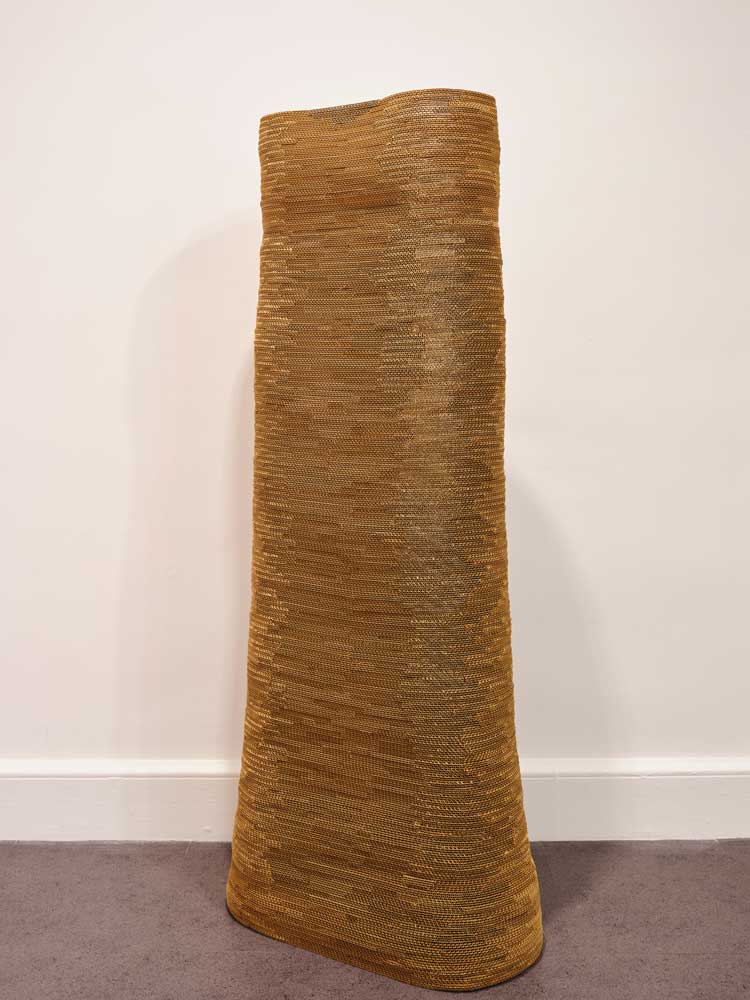
Maud Cotter. One Way of Containing Air, 1998. Installation view, Take a Breath, IMMA – Irish Museum of Modern Art, Dublin, 14 June 2024 - 17 March 2025. Photo: Ros Kavanagh.
Opposite this work is One Way of Containing Air (1998), a tall, woven cardboard, totem pole-like structure by Maud Cotter. Its delicate mesh of brown cardboard strands, and the undulations of its elongated, torso-esque form immediately evoke the idea breath – the exchange of air between outside and inside our bodies.
A small anteroom beyond this contains Marina Abramović’s Freeing the Memory, a little-seen work from IMMA’s collection, taken from a 1975 performance by the artist. Abramović performed the act of emptying her mind of words to make space in her brain. Within the frame is a list of all the words that emerged during the performance, sandwiched between images of Abramović in action.
-V-Simpson.jpg)
Marina Abramović, Freeing the Memory, 1975. Framed black and white photograph with framed letter press text panel, 124.5 x 61 cm. Installation view, Take a Breath, IMMA – Irish Museum of Modern Art, Dublin, 14 June 2024 - 17 March 2025. Photo: Veronica Simpson.
Saye’s remarkable photographic series follows, called In This Space We Breathe (2017-18). Made using the collodion photographic process (printing the photos on to metal sheets to produce tintypes) in these sepia-toned images, the artist poses for nine portraits, each featuring an item of spiritual and ritualistic value in Gambian culture. British born of Gambian parentage, Saye wrote about this series: “In these questionable times, we need positive imagery to push against the vile xenophobia and trash headlines.”
-2018-Pic-V-Simpson.jpg)
Khadija Saye. Ragal (Fear), 2018. Installation view, Take a Breath, IMMA – Irish Museum of Modern Art, Dublin, 14 June 2024 - 17 March 2025. Photo: Veronica Simpson.
In one from 2018, titled Ragal (Fear), the caption informs us that Saye is wearing goat’s horns on her fingers as she shields her face. Goat’s horns, we learn, are used in Gambian ceremonies of divination – the rituals for interpreting and predicting past, present and future events – and the fact that she is shielding her face implies a fear of the future. How heavy the extra weight this image must bear, given that that this was the last set of photographs this promising young artist worked on, before her untimely death. As Cremin says: “This says a huge amount about the inequity of the breath, the responsibility of the state to take care of different minorities as well.”
In a darkened room all to itself is the film Respire (Liverpool) (2023) by the Austrian artist, writer and researcher Belinda Kazeem-Kamiński. For this, she worked with black Liverpudlian communities, and generations within communities, to create portraits of individuals inflating large, red balloons; their breathing forms the soundscape as they stare steadily into the camera lens. This work was commissioned for the 2023 Liverpool Biennial, says Cremin. “She is looking at black breath as a means of revolution and empowerment.”
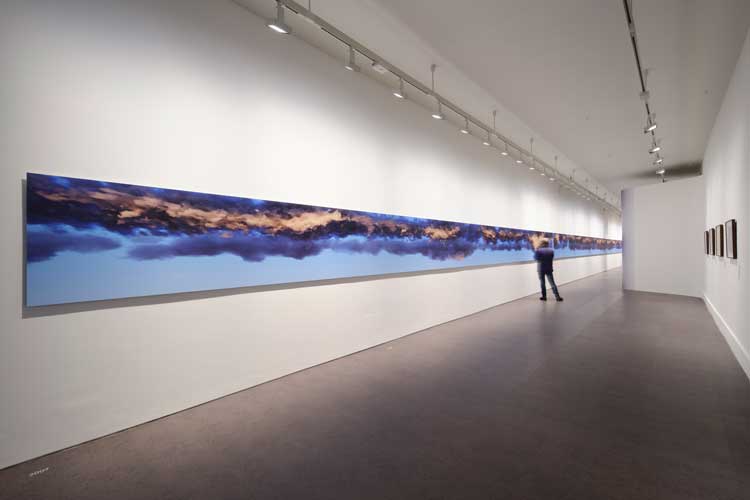
Lawrence Abu Hamdan, Air Conditioning (2010), 2022. Installation view Take a Breath, IMMA – Irish Museum of Modern Art, Dublin, 14 June 2024 - 17 March 2025. Photo: Ros Kavanagh.
Crossing the end of the corridor where Cecchetti’s wafting curtains and soundscape conclude, we turn a corner into a long gallery with rooms off along the right-hand side, and the entire length of Lawrence Abu Hamdan’s 2022 work Air Conditioning stretching into the distance along the left-hand side. With the fierce attention to detail and data that typifies Abu Hamdan and his fellow Forensic Architecture cohort, he shows us the results of visually mapping the Israeli army’s unauthorised incursions into Lebanese airspace, from 2007 to 2022. We see filthy, grey clouds of aircraft vapour billowing over the same stretch of Lebanese land, with the dates added in a timeline below to show this continuous and illegal intrusion. Cremin chose this work to articulate the oppressive impact of “slow violence”, as described by Rob Nixon in his book Slow Violence and the Environmentalism of the Poor.
Further down this long gallery, we see Forensic Architecture’s “Tear Gas Tuesday” in Downtown Portland (2020), demonstrating the consistent use of teargas by US police forces, as deployed in Portland during incidents in 2020, and its horrific impacts on the respiratory capacity of those present.
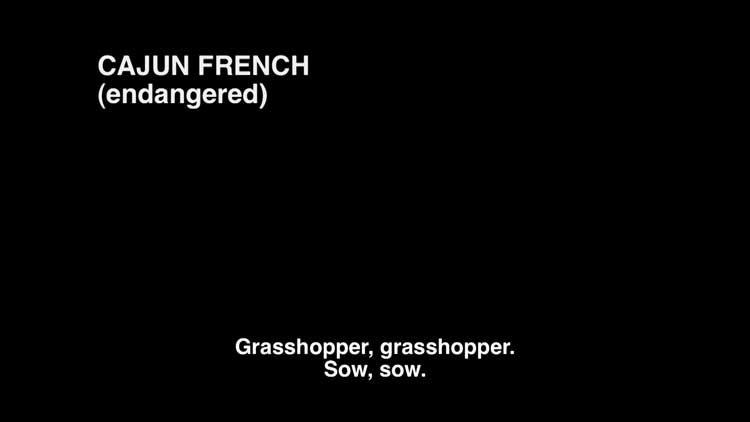
Susan Hiller, The Last Silent Movie, 2007. Single-channel projection, with sound, 20 mins 30 secs. Estate of Susan Hiller; Courtesy Lisson Gallery.
The ways in which breath – as language – can be silenced is movingly explored in an adjacent room with Susan Hiller’s The Last Silent Movie (2007-08) – a 22- minute film, experienced mostly as sound, with subtitles, offering us the last recordings of several of the world’s extinct and endangered languages. In this chapter, Cremin was looking for art that would articulate concerns around Ireland’s own disappearing native language, but found very little other than Niamh McCann’s Shh … / Fuar Anocht Beanna Boirche, a neon scrawl in the ancient Irish script of Ogham with pictorial elements.
More legible manifestations are Hajra Waheed’s Studies for a Sound Chamber 1-9 (2023): concentrated whirlwinds of black ink (created by moving a full pen of ink in circular motions, while humming, until it ran out). They pirouette across a wall, expressing in their primal simplicity the power of song and the human voice, especially when raised in protest. In the accompanying caption, Waheed says: “Humming is an utterance we are all capable of making even when our lips have been sealed shut.” Nearby is another of her works, A Letter from My Sister, November 16, 2015 (2023). This is an audio recording of a letter from the artist’s sister describing the experience of living under the state of emergency imposed in Paris after the Bataclan attack.
![Sheroanawe Hakihiiwe, Masiko kekipi [Palmeras de espiritus que abanican el mundo / Palms of spirits that fan the world], 2023. Photo: Colin Davison, courtesy of the artist, Cecilia Brunson Projects and ABRA Caracas.](/images/articles/t/050-take-a-breath-2024/DSC_5171b.jpg)
Sheroanawe Hakihiiwe, Masiko kekipi [Palmeras de espiritus que abanican el mundo / Palms of spirits that fan the world], 2023. Photo: Colin Davison, courtesy of the artist, Cecilia Brunson Projects and ABRA Caracas.
The atmosphere is lifted with the enduring elemental painted representations from Sheroanawe Hakihiiwe: motifs of leaf, feather and tree. But these are all symbols of the endangered Yanomami people who live in the Amazon rainforest, to which the artist is drawing our attention, as gestures of environmental and cultural continuity (last seen at 2022’s Venice Art Biennale).
Cremin has created a moment for pause, for us to consider the historical and environmental context of our modern-day experience, by adding in a timeline. An elliptical room features vertical lines spaced around its walls representing about 30 major dates from the last 150 years. Within these lines are described the major catastrophes or inventions that have had an impact on the air we breathe, from the industrial revolution to now. It is sobering reading, especially accompanied by Ammar Bouras’s haunting film next door, titled: 24°3′55″N 5°3′23″E (2012/2017/2022). The title refers to the co-ordinates of the “Béryl Incident”, of May 1962, when the French carried out underground nuclear tests in the Algerian desert. We hear snippets of speech from locals who witnessed the subsequent impact on human and plant life, against a backdrop of clouds, barbed wire and desert.
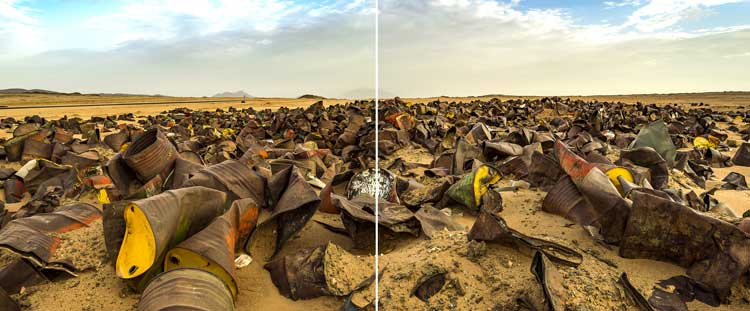
Ammar Bouras. 4°3′55″N 5°3′23″E #5, 2012, Photographies numérique, dimensions variable.
More environmental catastrophes – of the past but strongly referencing the present and future – emerge in Mark Ruwedel’s photographic series Four Ecologies. Over the last decade, he has been documenting the buildings and streetscapes of wider Los Angeles that have been ruined by desertification or forest fires. The abandoned concrete structures and empty, palm-tree-lined roads have more than a whiff of future apocalypse and question man’s determination to occupy environments that would usually be regarded as uninhabitable.
![Yuri Pattison, Sun[set] (Provisioning), 2019 (left) with JMW Turner](/images/articles/t/050-take-a-breath-2024/IMM0624BH135.jpg)
Yuri Pattison, Sun[set] (Provisioning), 2019 (left) with JMW Turner's sunset. Installation view Take a Breath, IMMA – Irish Museum of Modern Art, Dublin, 14 June 2024 - 17 March 2025. Photo: Ros Kavanagh.
We move gratefully into the largely lighthearted pairing of works in the next room: Yuri Pattison’s Sun[set] (Provisioning) (2019) with a deliciously weird JMW Turner sunset. While Turner’s landscape compels us with its utopian pastoral landscape coloured as something altogether more toxic (he was famously intrigued by skies that reflected pollution), Pattison’s digital screen presents a tranquil sunset on water, but the palette and water patterns shift minute by minute in response to sensors in the room that detect visitors’ movement and breath.
-Pic-V-Simpson.jpg)
One painting from William McKeown's series Tomorrow. Installation view, Take a Breath, IMMA – Irish Museum of Modern Art, Dublin, 14 June 2024 - 17 March 2025. Photo: Veronica Simpson.
So, to the more meditative part of the show – a welcome break from man’s inhumanity to man and planet. William McKeown’s Tomorrow series of dark canvases are peculiarly eloquent, maintaining their sombre soot-black tone but relieving the eye through different grids of ridged seams. His practice was all about exploring the liminal space between inhale and exhale, life and death, says Cremin. Around the corner, we have a large, pale painting that presents the luminous opposite, his 2005 Hope Painting (Going Through the Looking Glass). Nolan’s Deep Time tapestry occupies its own deliciously yellow-tinted room (with walls painted buttercup-yellow and a matching curtain). The work itself recreates religious architecture and artworks, evoking stained-glass windows and timeless geometries in its arched forms and swirling shapes and pattern. Cremin says: “Her works give generous form to fundamental questions about the ways the chaos of the world is made beautiful or given meaning through human activity.”
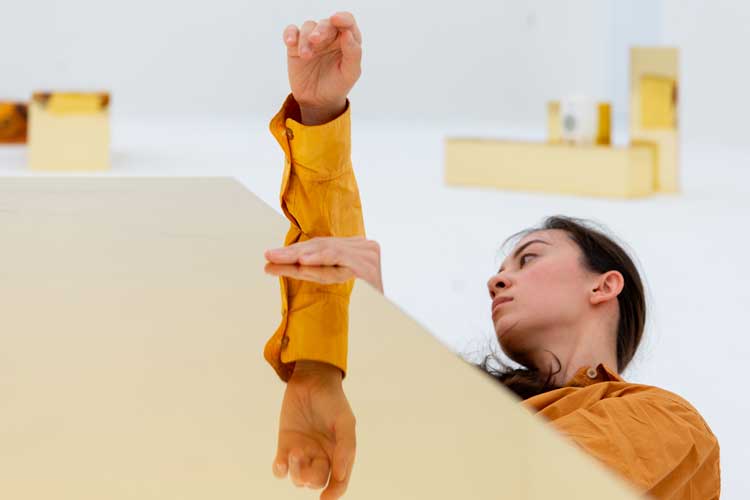
Maria Hassabi: White Out, 2023. Installation view, Tai Kwun Contemporary Hong Kong, 2023. Performer; Solong Zhang.
Photo; Thomas Poravas. Courtesy the artist.
It is with some relief that we approach the room at the end of this long gallery, featuring two of Patrick Scott’s meditative geometries – silver acrylic and gold-leaf paintings – accompanied by reflective benches. Over one of these shiny seats, a large painted portrait of the artist Maria Hassabi is draped, before the scheduled performance here, later in the summer, of her work White Out (2023), reflecting on time, the human figure and breath. Cremin says: “It was important to me to have movement and dance to activate the galleries throughout the exhibition.” During the show’s long run, there will be multiple further events, screenings and performances that delve deeper into the many perspectives and contexts it offers.
-JanLiegeois.jpg)
Waqas Khan, The Blue Circle, 2023. Ink on canvas, 244 x 244 cm. Image courtesy of the artist and Axel Vervoordt. Photo: Jan Liégeois.
Down the long gallery, McKeown’s Hope Painting is followed by three stunning works from 2023 by Waqas Khan. Elaborate, painstaking, mark-making is visible across these large inky canvases. Varying from delicate white markings against a compelling Yves Klein blue, a corporeal red patterning on white, and a soundwave-esque white on black, it is hypnotic to stare into their densely figured surfaces. They spontaneously transmit the slow, patient, meditative work entailed. Cremin’s exhibition text expresses it best: “These expansive minimalist drawings, composed of tiny dashes and dots, evoke the interconnectedness of particles and the cosmos … inviting viewers to reflect on the micro and macro levels of existence, creating a visual dialogue akin to meditation.” Indeed, they do. I stood rooted to the spot for several minutes in front of each one.
I like the way the layout of these galleries, and the works within them, mean that we return the way we came, exiting via Cecchetti’s tranquil underwater environment. The presence of these more contemplative and timeless works, alongside those that express the chaos of the modern world, create an expanded sense of who we are in this place, in these times – and the resilience contained in the human body, mind and spirit.